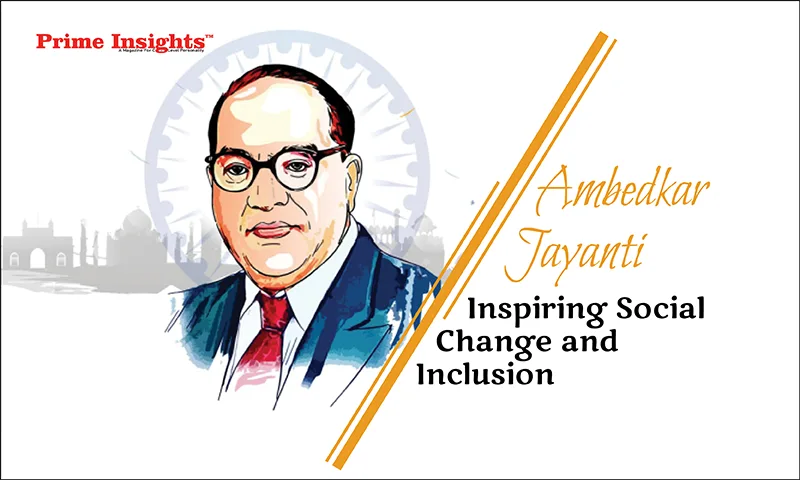Ambedkar Jayanti: Inspiring Social Change and Inclusion
Every year, we celebrate Ambedkar Jayanti on April 14th to honor the contribution of the chief architect of the Indian Constitution, famously called the ‘Father of the Indian Constitution’.
Dr. BR Ambedkar, popularly known as Babasaheb Ambedkar, was a social thinker, politician, and economist who made an immense contribution to many social reforms.
The Journey of the Great Dr. Bhimrao Ramji Ambedkar, the Former Minister of Law and Justice of India.
He was born on April 14, 1891, in Mhow, a small village in the Indore district of Madhya Pradesh, to Ramji Sakpal, who was a subedar in the Indian Army, and Bhima Bai. His family was from a Marathi background and lived in the town of Mandangad taluka in Ratnagiri district. He was born into a dalit caste, which led to his being treated as untouchable and subjected to various forms of discrimination. He faced many forms of discrimination in school, like when untouchables were segregated and provided with no proper education. They were not allowed inside the class. The only way to drink water in school was for them to have the water poured from a height by a higher-caste person, usually the peon, and if the peon was not available, then they had to go without water.
After his father retired in 1894, they moved to Satara in Maharashtra, and within the next 2 years, they were hit by the tragedy of his mother’s death.
Babasaheb Ambedkar was an exceptional student who was the only lower-caste individual at that time to get into Mumbai’s high school. His family had moved to Mumbai in the year 1897. At the young age of only 15, Babasaheb was married to then 9-year-old Ramabai.
After successfully passing his matriculation examination, he entered Elphinstone College, affiliated with the University of Bombay. He was the first person from his caste to do so, and in 1912, he got his degree in economics and political science.
In 1913, he was awarded a Baroda State Scholarship of £11.50 per month for three years under a scheme established by Sayajirao Gaekwad III that helped him to move to America for his higher education degree of post-graduation (M.A.) from Columbia University. By 1916, he had enrolled in the bar course at Gray’s Inn and, during that time, also enrolled at the London School of Economics, where he was working on a doctoral thesis.
But by June 1917, he had to return to India because his scholarship from Baroda ended, leaving his studies. After returning to India, he started taking up jobs like accountant, clerical, etc. He completed his research in 1923 by going back to London and submitting his research.
In 1926, he became a member of the Mumbai Legislative Council, and in October 1935, he was made the principal of the Government Law College, where he worked for 2 years.
When he was practicing law in the Bombay High Court, he devoted his time to promoting education for untouchables. His first attempt was the establishment of the central institution, Bahishkrit Hitakarini Sabha, which was intended to promote education for socio-economic classes in backward castes.
During 1927, Babasaheb launched active movements against untouchability. He began with various public movements and marches to make public drinking water accessible to all. He also began a struggle for the right to enter Hindu temples, due to which, in 1930, he launched the Kalaram Temple movement with 15,000 volunteers towards Kalaram Temple, making it the greatest processions of Nashik at that time.
On September 25, 1932, the Poona Pact was signed between Babasaheb, who was representing all the lower castes, and Madan Mohan Malaviya, who was representing the other Hindu castes. The agreement stated that it would reserve 148 seats for the backward castes in the provincial legislatures within the general electorate.
In the year 1935, he lost his beloved wife, Ramaba, due to prolonged illness. By the next year, he had formed his political party, the Independent Labour Party, and contested the 1937 Bombay election to the Central Legislative Assembly.
During 1941 and 1945, he published many books. He strongly opposed the demand for creating a separate country for Muslims. He wanted to see the whole country united and strongly criticized the policies of the Indian leaders who were supporting the partition of India. After the independence of India on August 15, 1947, he became the first law minister.
He remarried Sharada Kabir on April 15, 1948, who changed her name to Savita Ambedkar.
In 1952, Babasaheb Ambedkar contested the Bombay North first Indian General Election but lost to the Congress Party candidate and his former assistant Narayan Sadoba Kajrolkar. He then went on to become a member of the Rajya Sabha.
On December 6, 1956, Babasaheb Ambedkar passed away due to his deteriorating health. He was cremated in the Buddhist way, which was organized at Dadar Chowpatty Beach on December 7 and was attended by more than half a million people.
Conclusion
Babasaheb Ambedkar’s contributions have been huge towards the upliftment of Dalit castes. He fought for the rights of the Dalit community by organizing several notable events like the Equality Janta, Mook Nayaka, Kalaram Temple Movement, etc. He is celebrated across the world for his knowledge of different higher degrees, like MSc, M.A., PhD, etc. The Congress government made him the first law minister when the country was freed from British rule on August 15, 1947. He was then chairman of the Constitution Drafting Committee. He was responsible for crafting the new constitution for the country, and the Constituent Assembly adopted the new constitution on November 26, 1949. He believed in promoting the agricultural sector and industrial activities. He worked towards the upliftment of backward castes by also motivating people for better education, health, and opportunities.

